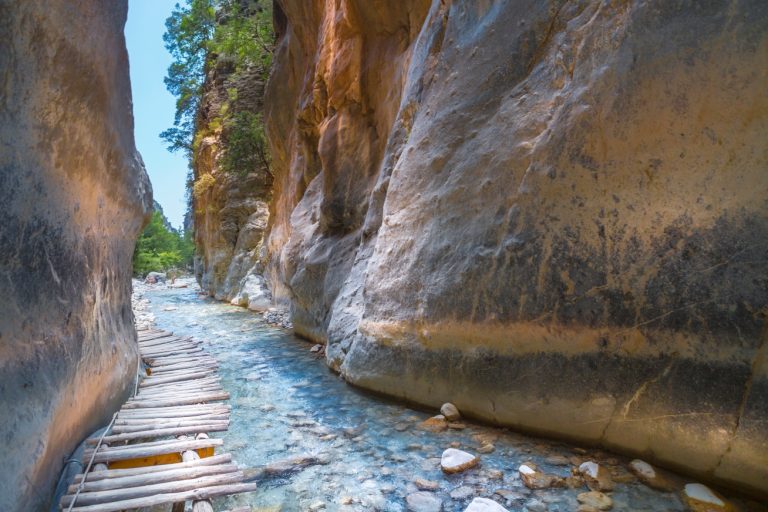
You are using the Free Edition of CreteAPP. For extensive information on Crete, GO PRIME with our comprehensive Greek Travel App featuring the full editions of Crete and 25more Greek islands & Athens.
The Gorge of Samaria lies on the southern side of Chania prefecture and is a wonderful place for hikers. Visitors from all over the world attempt trekking at this gorge. In 1962, Samaria Gorge had been declared a National Park for the survival of the endangered species kri-kri, the rare Cretan wild goat that lives only in Samaria. Apart from the kri-kri, many other endemic and rare species of flora and fauna live in this gorge.
A small village used to be there, Samaria village, but it was abandoned by all its inhabitants in 1962, to make the gorge a national park. The village and the gorge were named after the church of Santa Maria that is found inside the gorge.
The length of this gorge is 16 km and it is said to be the longest gorge in Europe. It has been created by a river that runs between the enormous White Mountains and Mount Volakias. The gorge begins below the northern side of Omalos Plateau and ends in the shores of the Lybian Sea, at the village of Agia Roumeli.
The actual distance of this long trek in the park itself is 13 km, but from the exit point of the park, one has to walk another 3 km to reach the village of Agia Roumeli, from where one can get transportation services, thus making it a total of 16 km long trek. The breadth of the gorge differs from 150 m to 3.5 m. At the highest points, these looming mountain walls reach a height of 500 m above sea level. The time taken to complete the trek differs from 4 to 7 hrs, depending on the capacity of every trekker.
Trekking begins from Xyloskalo, the steep stone pathway bordered with wooden rails. This is the access point of the gorge. For the first 6 km, the gorge is wide and spacious up to the deserted village of Samaria. After that, you will notice that the gorge tends to narrow down and when you reach 11 km mark, the gorge at this point is only 3.5 m apart. This part is known as the Iron Gates. The gorge ends at 13 km mark. But trekking does not stop here. You have to walk another 3 km to the seaside resort of Agia Roumeli, where there are plenty of local ferries to take you to the village to Hora Sfakion. From this village, you can take the bus to go back to Chania.
This gorge is only open from early May to late October. The park remains open from 7 am to 3 pm. After 3 pm till sunset, you can only walk 2 km distance, either from Xyloskalo or from Agia Roumeli. You have to be in good physical condition to take on this trekking path because it can be very exhausting, especially in summer when the sun is burning hot.
The best time to visit is in spring, when the weather is cool, nature is at its best and visitors are far fewer than in summer. If you realize within the first 1 hour that the journey is too difficult for you, then you should stop and there are forest guards with donkeys, who can take you back from where you started the journey. Guards with radio contact to each other are found all over the way in case one gets injured or dizzy and a doctor stations in the abandoned village. Toilets and rubbish bins are found frequently on way, too.
As the gorge is a national park, it is not allowed to swim in the streams, camp, light fires, hunt or stay overnight. Visitors are not allowed to trek the whole park after 3 o’clock in the evening because the authorities want to make sure that nobody will stay at night in the park.
There are operators and guides to organize trips from Chania Town to Samaria Gorge or you can take the public urban buses from Chania Town to Omalos. The last boat from Agia Roumeli to Sfakia leaves at 17.30. The bus from Sfakia to Chania Town leaves at 18.30 and the driver waits for the boat from Agia Roumeli to come before the bus departs.
Sorry, no records were found. Please adjust your search criteria and try again.
Sorry, unable to load the Maps API.
